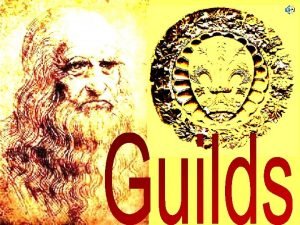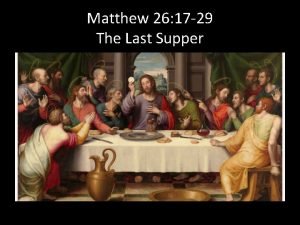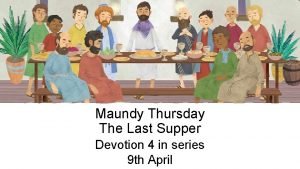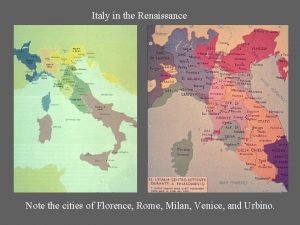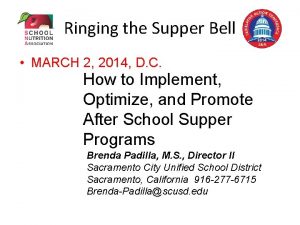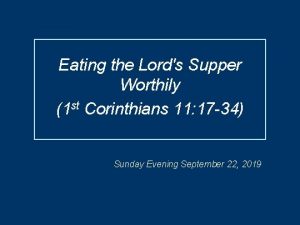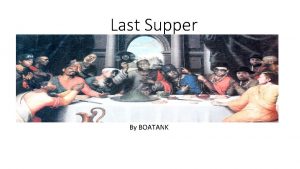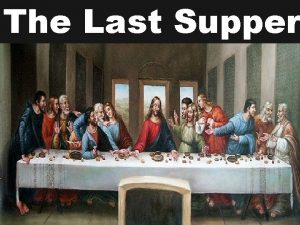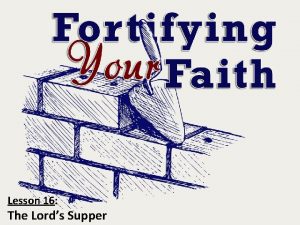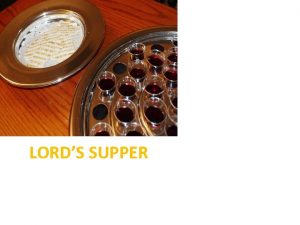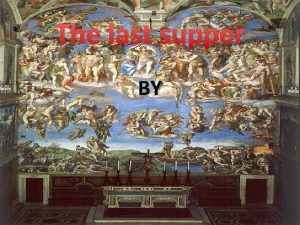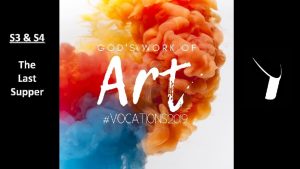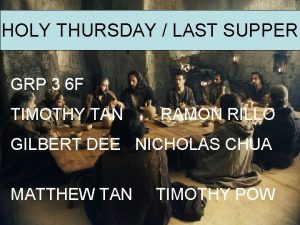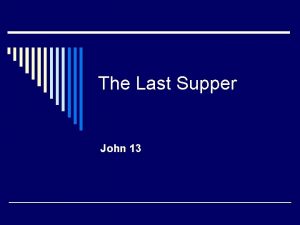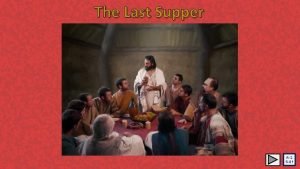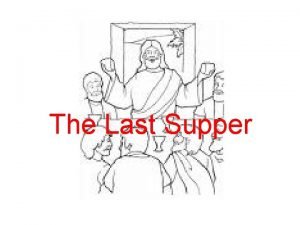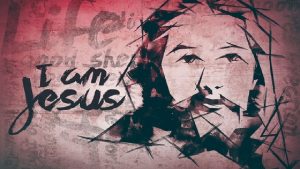S 3 S 4 The Last Supper Introduction
























- Slides: 24

S 3 & S 4 The Last Supper

Introduction § This week the Catholic Church in Scotland celebrates Vocations Awareness Week – a week of prayer, reflection and celebration of the truth that God calls people to serve Him in the Priesthood. § For centuries, the Christian faith has provided inspiration for countless artists across the world. As we mark this week in our Catholic schools across Scotland, we’ll be thinking about how artists have portrayed theme of ‘Vocation’ in their work! § We’ll be looking at some of the most famous works of art and seeing how they can speak to us in the here and now of our lives!

Starter Activity Starter activity (a) How many famous pictures/paintings can you name? (b) What is going on in the picture / What story does it tell ? (c) Think of pictures/images you may have viewed in your local Church. What pictures are there? (d) Why do we have lots of images in our Churches ?

Starter Activity § We find many images in our Churches as they help us focus on the mysteries of our Faith. § Some images such as the Stations of Cross tell the story of Jesus’s last hours. § In years gone by Stained Glass windows were commissioned to show Bible stories etc, since the majority of people could not read.

The Last Supper § Leonardo Da Vinci began working on this painting in 1495. He took about ten years to complete it. He was, we’re told, a master of procrastination, or putting things off until tomorrow! § The picture wasn’t made for a private art collection or an art gallery. The picture, rather, was painted on the wall of the canteen of a monastery in Milan, Italy. It was hoped that looking at the picture would inspire the monks as they gathered in the canteen three times a day for meals. The painting can still be found at the exact same spot in the canteen!

Original (now faded) picture

Digital restoration by leonardoresearch. com

Activities For Reflection/Discussion: Can you find more about Leonardo da Vinci’s life and his contribution to art, science and mathematics? Do you have a motivational poster in your room at home? Why do think the monks wanted to see an image of the Last Supper? On your own: What kind of motivational image or motto would you display in your canteen if you had the choice? Can you produce a poster displaying what you think should be the aims and goals of your school?

Controversy § The monks weren’t entirely happy when Leonardo showed them his completed work. § Firstly, they thought the scene was too violent! Until Leonardo, pretty much every painting of the Last Supper up until now had involved Jesus blessing the bread and wine - a nice, serene scene. § Judas was always shown off in a corner, sulking, away from the rest of the disciples. This is what the monks thought they were getting. When they instead got this "violent" version with the disciples all screaming and yelling, the monks were not exactly pleased. It created a lot of publicity! § Instead of depicting Jesus saying the familiar words “This is my body, this is my blood…”, Leonardo chose to focus on the scene seconds after Jesus has revealed that He knows he is going to be betrayed. The disciples are pictured arguing about who has betrayed Jesus (read John 13: 21).

The Last Supper John 13: 21 -30 21 After saying this Jesus was troubled in spirit, and declared, “Very truly, I tell you, one of you will betray me. ” 22 The disciples looked at one another, uncertain of whom he was speaking. 23 One of his disciples—the one whom Jesus loved—was reclining next to him; 24 Simon Peter therefore motioned to him to ask Jesus of whom he was speaking. 25 So while reclining next to Jesus, he asked him, “Lord, who is it? ” 26 Jesus answered, “It is the one to whom I give this piece of bread when I have dipped it in the dish. ” So when he had dipped the piece of bread, he gave it to Judas son of Simon Iscariot. 27 After he received the piece of bread, Satan entered into him. Jesus said to him, “Do quickly what you are going to do. ” 28 Now no one at the table knew why he said this to him. 29 Some thought that, because Judas had the common purse, Jesus was telling him, “Buy what we need for the festival”; or, that he should give something to the poor. 30 So, after receiving the piece of bread, he immediately went out. And it was night.

Controversy § A second complaint was regarded how the disciples were depicted. Usually in religious art all the disciples (except Judas) were depicted as wearing ‘halos’. § This indicated that they were saints. Leonardo didn’t do this! All the disciples including Judas were shown without halos. The Halo In religious art, the halo is a circle of light or crown of light rays that surrounds the head of the Holy Person. Another artist’s depiction of the Last Supper – halos included! The Halo represents God’s divine grace spreading through the soul.

Activities For Reflection/Discussion: Betrayal is generally understood as one of the most painful emotional experiences anyone can have. Why do you think this is? By not painting the disciples with “halos”, Leonardo is possibly saying that it’s up to God to judge who are saints and sinners. Do you think he’s right? On your own: What are the range of emotions you can see in the pictures? Some disciples appear angry, some confused and some look very thoughtful. Imagine yourself in the room with Jesus as he announces He is going to be betrayed. Write down how you would feel on hearing that news? What would you feel about Jesus? What would you feel about the person who has chosen to betray Him?

Symbols & More Symbols Chalice / Cup One of the central themes of the Last Supper story is the Holy Cup or Holy Grail. It’s commonly held that at the Last Supper one large cup was passed around for everyone to drink from. However, if you look at the table, you'll see that each person has their own, small cup. Moreover if you look closely there are only 12 cups while there should be 13. Where is the missing cup? Did Leonardo simply forget it? Is there a hidden meaning?

Symbols & More Symbols The Spilled Salt Many scholars have discussed the meaning of the spilled salt container near Judas's elbow. Spilled salt could symbolize bad luck, loss, religion, or Jesus as salt of the earth!

Symbols & More Symbols Light In the painting its obviously day-time outside but the Bible clearly says that the Last Supper took place at night. Moreover, in the picture, the main source of light for the painting is Jesus himself - it is "light from Jesus" that falls on the scene.

Activities For Reflection/Discussion: Why do think Leonardo gives each disciple a cup? In the Gospels, Jesus tells his disciples that having to “drink the cup that he must drink” means that they too will have to suffer a similar fate to his. Do we all have to ‘drink’ a cup of suffering when we follow Jesus? Spilled salt What do you think Leonardo wants us to think this means? Does it signify bad luck, loss, religion, or Jesus as salt of the earth? What do you think? Light The idea of Jesus as the ‘light of the world’ was obviously very important to Leonardo. How do you think Jesus is the ‘light of the world’ ? On your own: Jesus refers to Himself as ‘the Light of the world’ (John 9: 5). In other places, he calls Himself ‘the Good Shepherd’, ‘the True Vine’ and the ‘Door’. What is your favourite image of Jesus and why? Can you produce a picture of your favourite image of Jesus?

The Disciples § What is really fascinating about this picture is the very real and totally human way in which it depicts the apostles. Until Leonardo’s work, they would have been depicted in a very bland kind of way, to the extent that you couldn’t really pick out who was who. The only one who would be easily identifiable would be Judas because he was the baddie!!!!! § Leonardo didn’t see it that way, however. He saw the disciples as individual human beings, with their own histories, personalities, emotions, strengths and weaknesses. He recognised, in his own way, that Jesus didn’t call twelve “clones”, but twelve men who couldn’t have been more different. We’ll now think about these men as Leonardo depicts them.

The Disciples – St John § Just to the right of Jesus we have John was, according to tradition, the youngest of the disciples, probably about 18, so that is why he is so fresh faced! § One of the weird things about John is that, whenever you see him in any painting of the Last Supper, he always seems to be asleep or half asleep. He’s never quite all there. This is because John is always seen as the dreamer, the idealist and the thinker. § In our schools, in our communities we need dreamers and we need people who think outside the box! We need idealists, we need their optimism, we need their energy, we need their youth. We all need a John!!!! Original (now faded) picture Digital restoration by leonardoresearch. com

The Disciples – St Andrew § Andrew, like most of us, lived his life in the shadow of someone else. For many people Andrew is simply the younger brother of Peter, the head of the apostles. Andrew is always seen as being in his shadow, his side kick, his second in command. § Many of us have been compared to brothers and sisters, always coming up short. But we also do it to ourselves. We always compare ourselves to people in our class, people in our year. We say to ourselves “I wish I was as clever as her, or as good at sports as him, or as good looking at her, or I wish I had the friends he has”. Nonmatter how hard we try we can never quite be the same as that person: they always have that something we don’t. No matter what we buy, how we dress, what we say we never quite get there. § Well here’s a newsflash: in here it doesn’t matter! God loves us for who we are. He created us, breathed us into life because he loves us. He loves you not because you’re quite like someone else or a bit like your neighbour but because of who you are! § That was the truth, Andrew accepted and understood. He knew Jesus loved him not because he was Peter’s wee brother but because he was Andrew. He knew that God loved him from the moment he was created and that love would never change or go away or disappear. Original (now faded) picture Digital restoration by leonardoresearch. com

The Disciples – St Thomas § Thomas is the disciple on the right hand side of Jesus. Thomas is pointing upwards. Why is he pointing upwards? A clue is given in St. John’s account of the Last Supper. Before Jesus announces that He is going to be betrayed, Jesus tells the disciples that He is leaving and that they should know where He is going. Thomas speaks up and says that he, for one, has no clue where Jesus is going! Jesus then says that he is ascending, ‘going up’ to his father. Hence Thomas’ gesture! § In the chaos of the picture, Thomas is possibly the one disciple who seems to remain relatively calm. He seems to be very levelheaded and to have lots of common sense. Every group needs a Thomas, the person who thinks everything through, the person is logical, calm and self-assured. That’s precisely why he was one of the Twelve! Original (now faded) picture Digital restoration by leonardoresearch. com

The Disciples – St Peter § Leonardo’s depiction of Peter is also quite interesting. Some say he is making a threatening gesture towards John, but it’s more likely he’s trying to clarify just what has he heard. § In the Gospels, Peter comes across as a ‘do-er’, a man who of action and a man who’s passionate about his beliefs. § In so many ways, he’s the type of person every group needs! Original (now faded) picture Digital restoration by leonardoresearch. com

The Disciples – Judas § The depiction Leonardo gives of Judas is really interesting. Up until this picture, Judas was always really easy to pick out in any depiction, as he was the disciple without the halo! But here it’s different, Judas is right there in the middle of the group. In fact he’s quite close to Jesus, closer even than Peter. Is think Leonardo is perhaps trying to say something? § You’ll see Judas has around him, symbols of betrayal - in his hands he has the bag with the thirty pieces of silver; just in front of him you can just pick a spilled salt container. In old traditions, that was a sign of broken trust. § A common legend surrounding the painting is that the same model was used for both Jesus and Judas. The story often goes that an innocent-looking young man, aged nineteen, a baker, posed as Jesus. Some years later Leonardo discovered a hard-bitten criminal as the model for Judas, not realizing he was the same man. § But despite all that Leonardo puts Judas right at the centre of things, he seems to be saying, that despite his obvious failings, Judas had some good qualities. § Jesus picked Judas as a disciple. When he did so he knew he was taking a risk. Sadly that risk didn’t quite work out. Judas let him down. But more often than not the risk was worth it, the other eleven were all weak fallible people like us but in the end they came good. § It’s the same with us. God picks us. He knows he’s taking a risk. He knows it might not work out, but that’s ok: it’s a risk he’s prepared to take. Original (now faded) picture Digital restoration by leonardoresearch. com

Activities For Reflection/Discussion: Working in small groups discuss which Apostle you are most like: 1. John the Dreamer 2. Andrew the ‘quiet man’ – the person who lives at times in the shadow of someone else 3. Thomas – The Thinker 4. Judas – a bit of a mixed bag, sometimes good sometimes nasty 5. Peter – the doer

#chaplainchat Invite your school chaplain or a local priest into your class to speak about his vocation. Using some of themes we touched on previously, you may ask Him to reflect on the following: Motivation: What motivates and inspires the Priest in his ministry? Were there other priests he looked up to? Were there priests in his life whose example led him to consider the priesthood? Gifts: What particular gifts does the Priest have? What gifts does he think are important in priests today?
 Last supper painting judas
Last supper painting judas Italian guilds
Italian guilds Matthew 26: 17-29
Matthew 26: 17-29 Last supper liz lochhead annotated
Last supper liz lochhead annotated The golden ratio
The golden ratio Last supper chapter
Last supper chapter Mona lisa
Mona lisa Leonardo da vinci was born on april 15 1452 in vinci italy
Leonardo da vinci was born on april 15 1452 in vinci italy Sharing
Sharing Holy thursday cartoon
Holy thursday cartoon Last supper labeled
Last supper labeled How to memorize polyatomic ions song
How to memorize polyatomic ions song Cabenda
Cabenda Complexe sentence examples
Complexe sentence examples Supper prediction
Supper prediction Democritus periodic table
Democritus periodic table Who is mrs sloane in the great gatsby
Who is mrs sloane in the great gatsby What caused the beverly hills supper club fire
What caused the beverly hills supper club fire 1 corinthians 11:23-34 kjv
1 corinthians 11:23-34 kjv Supper bell
Supper bell The supper of the lord
The supper of the lord Matthew 26 35
Matthew 26 35 Miss drake proceeds to supper
Miss drake proceeds to supper 1 corinthians lord's supper
1 corinthians lord's supper Tuesday supper
Tuesday supper

